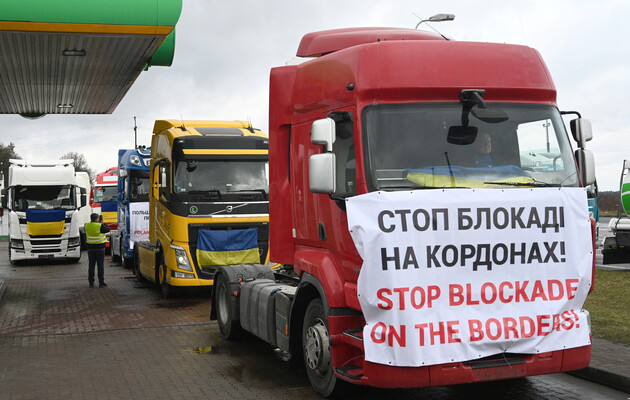Another Blockade: Is Fuel Market Ready?

The transport crisis at the Polish border in November 2023 was an important factor in the changes in the petroleum products market. The protests of European partners had the greatest impact on the autogas market, when some gas stations stopped selling gas. However, importers responded to the new challenge by rebuilding their logistics. How prepared are fuel market participants this time around, when the protests promise to be even bigger?
Diesel: block, don’t block...
In November 2023, consumers of diesel and petrol hardly noticed the effect of the Polish strikes. On average, 21% of the total volume of gasoline (about 20,000 tonnes per month) and 15% of diesel fuel (77,000 tonnes) entered Ukraine by road across the Polish border (see Figure 1). These volumes were transferred to other borders or to the railway.
The accumulated stocks, which the country was actively consuming while new supply channels were being established, helped to keep prices from rising.
During the short time that the Poles were planning a new blockade, the market restocked (amid low seasonal demand) and is now ready for new challenges.
“The expected price increase is entirely due to the rise in prices in Europe, and there is no impact of the border blockade,” says a representative of a company that imports the lion's share of diesel fuel through the western border.
It should be noted that in the first half of February, the price of diesel fuel in Europe increased by $70 per tonne on average, which is equivalent to UAH 2.7 per litre.
Traders are also calm in the south.
“Given that diesel prices in Ukraine are often lower than current European prices, I think the blockade will not affect the market in the near future. Fuel reserves and supplies from the Danube bases will have a restraining effect,” says Oleksii Dronnikov, CEO of the Ukrainian Oil Trading Company.
According to Ukrainian traders, the shutdown of refineries in the south will not affect the pace of supplies across the southern border. These are the scheduled repairs of the Romanian Rompetrol and Serbian NIS refineries in March.
LPG: expensive but not in short supply
LPG imports are more sensitive to the situation on the Polish border. In 2023, an average of 30% of imports entered through Polish road border crossings. And while Ukraine has a surplus of vehicles capable of travelling to Europe to buy diesel or petrol, it has fewer gas carriers. That is why the farmers' protests led to partial destabilisation of the market and a rise in prices.
However, thanks to the reorientation to southern sources and rail supplies from the west, stable supplies were restored within a month. According to the A-95 Consulting Group, during the autumn strike, the share of rail gas shipments from Poland and the Baltic states doubled compared to September (see Figure 2), to 22%, while the share of LPG imports from Romania increased from 35% to 51%.
Similar processes have already been launched again. Fortunately, less than a month after the border was fully unblocked, the railway rails are still warm.
“We have enough railway resources, we can triple the supply in a month,” says one gas trader.
However, it will take a lot of time to reorient to wagons.
“Currently, we have to wait about two weeks for the resource. Two-thirds of the time is spent on delivering empty wagons. We say that the Poles take a long time to deliver, and the Poles say that ours take a long time to deliver,” said one of the suppliers, noting, however, that this is a standard story that has been going on for two years.
Oil product traders are highly sceptical about the threats of Polish farmers to block railway terminals.
“The railway is a strategically important facility. The accumulation of wagons on it will lead to serious consequences for both Poland and Ukraine,” said one of the fuel companies. According to importers, there are currently no signs of preparations to block the railways.
Another factor that will make it easier to fill the market is the extremely low demand in the country.
“The standard seasonal drop in retail sales is 15%, and in the winter season of 2023–2024, some chains will see a 40% drop,” describes the scale of the decline in consumption the head of a Kyiv-based trading company.
However, there is no doubt that the transformation of logistics will lead to higher prices. The first shifts have already been recorded. At the auction of the Ukrainian Energy Exchange, the main price benchmark for autogas in Ukraine, on 14 February, the average price of gas rose by 9% to 42,023 UAH/tonne. Traders are already quoting 44,000-4,4500 UAH/tonne in their own prices and predict that the price of domestically produced gas will reach this level at the next auction.
“Prices will rise, that’s a fact. But not to UAH 60,000, as in autumn 2023. As for the deficit, there will definitely be no deficit within three weeks. Unless it is artificial,” commented one of the major fuel companies.
The Nadezhda company also believes that the blockade will lead to higher prices, but not to a shortage of gas on the market.
Traders estimate that reorientation of the purchased volumes under previously signed contracts will cost a pretty penny. Moving a gas carrier from Jagodzin to Porubne or Vyšné Nemecké will cost about $130 per tonne (UAH 5,000 per tonne), or UAH 2.7 per litre. We can predict that by the end of February, the rise in logistics costs will be reflected in the steles of petrol stations.
This increase will automatically make rail deliveries, as discussed above, more profitable. In addition, the price increase will obviously unlock the resources of a number of traders that have been lying in wait for better times since December 2023. At that time, operators were so eager to overcome the autumn crisis that they brought record volumes of gas. Due to low import volumes in January-February, the market ate up reserves, but there are still enough resources.
Cheap but expensive gas
The future dynamics of autogas price growth is significant, but it looks large due to the low comparison base. For example, the price of autogas at auctions in December 2023 fell to UAH 36 thousand per tonne due to a strong market overflow. This was almost 20% below import parity. However, as the market was filled, the price of LPG produced by Ukrainian producers did not rise. In January, another influx of suspiciously cheap gas from Poland and the Baltic States prevented the price from reaching import parity.
As a reminder, thanks to documentary manipulations in Poland, Lithuania and Latvia, Russian gas actively inundated the Ukrainian market in 2023. The situation was suppressed only in October last year, when the Energy Customs began demanding confirmation of the entire transport chain from the oil product producer to the Ukrainian border. But companies that receive tens of thousands of tonnes of gas from Russia every month in Poland and Latvia have found a new way: they mix Russian gas and call it production. And although these processes do not in any way fall under the definition of production, the product receives a “European” passport with the tacit consent of Polish regulatory authorities. Ukrainian customs can only shrug its shoulders.
In the first half of February 2024, the share of gas coming to Ukraine with a European passport from Polish terminals receiving Russian resources already accounted for 41% of total imports. Ukrainian traders are being forced to close their eyes and hold their noses by a very pleasant price. The advantage of Russian gas relative to truly European gas is an average of $150 per tonne, or 3.7 UAH per litre.
Unfortunately, we have to admit that the decline in autogas prices in early 2024 to UAH 25 per litre and below is the effect of the market's transition to Russian resources. That is why the effect of the next Polish blockade will be so noticeable.
According to our data, some processes to counteract the new loopholes of Polish entrepreneurs have already begun, but have not yet acquired specific contours.
In the meantime, the current confluence of factors can be used effectively to combat this shame.
“Now is the ideal situation for regulating the LPG market: it is a low season, Russian blends have not yet fully filled the market, the price will rise to the level of current import parity and open up non-Russian sources of supply. Therefore, no one will notice the disappearance of Russian gas from the Ukrainian market. And all of this without the threat of a shortage in the country,” the trader said.
***
Thus, there is no threat of a shortage of any type of motor fuel. This is the result of the market building a new diversified system of oil product imports with the support of the government. The unexpected Polish strikes were another test that Ukrainians have so far passed well. At the same time, the need to drive around the Polish section of the border will put pressure on the price of petrol and diesel fuel and is already pushing up the price of autogas. But, as the experience of 2022 shows, price is not the main thing.
Read this article in Ukrainian and russian.
Please select it with the mouse and press Ctrl+Enter or Submit a bug














 Login with Google
Login with Google